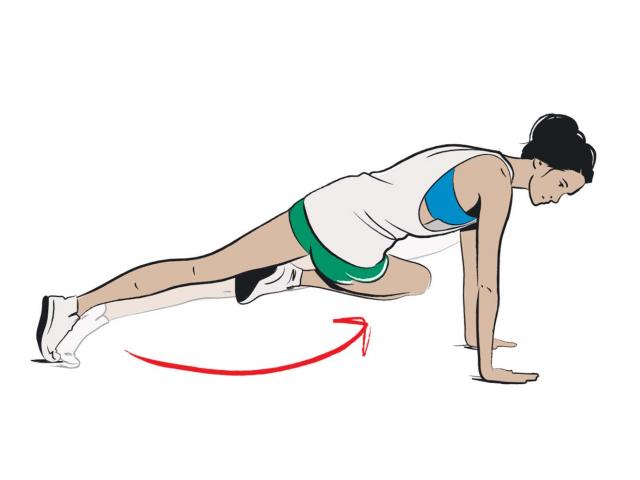Mountain climbers are calisthenic exercises that challenge your balance, agility, proprioception and coordination. They benefit muscular and cardiovascular fitness by increasing strength, flexibility and blood circulation. This exercise requires you to engage your upper arms muscles, as well as your core and your legs. Practice the proper alignment of mountain climbers to get the most out of your workout.
Anatomy of the Mountain Climber
During mountain climbers, your muscles are hard at work balancing, controlling and moving your body. Numerous muscles stabilize the upper arm bone into the joint, but the largest shoulder muscle at work is the deltoid. Your triceps keep your arms straight. Your abdominals along with your back muscles control your hips and sustain your core. The quadriceps of your back leg fully engage to keep your leg erect. The hip flexors fire up to draw your knee in toward your chest, and your butt muscles contract to extend the hip. In other words, you are getting a full-body workout.
Plank Position

Proper alignment of the mountain climber is essential in order to properly work out the muscles involved during this exercise. In the plank position, make sure your hands are directly underneath your shoulders, shoulder-width apart. The feet are hip-width apart and your toes are curled under. Your legs and arms are straight. Your tailbone is tucked under and your abdominals are strongly contracted, keeping your back from hyperextending. Your chin is slightly tucked in, and there is a straight line from the crown of your head to your heels.

After you’ve pushed through a set or two of mountain climbers, you’re sure you’ve burned off all your breakfast calories — and maybe some from lunch, too. This intense exercise, in which you get into the top of a pushup and quickly alternate stepping your feet to your hands, does burn loads of calories. But sustaining mountain climbers for more than just a minute or two is incredibly challenging. Combine mountain climbers with other calisthenics, such as jumping jacks, body-weight lunges and burpees, to burn around 300 calories in 30 minutes.
Bigger Burns
A smaller person burns fewer calories doing mountain climbers than a larger person. If you do a 60-second set of the climbers, expect to burn about 8 calories if you weigh 125 pounds, 10 calories if you weigh 155 pounds and 12 calories if you weigh 185 pounds.
The Movement
Once you are aligned in the plank position, draw your right knee into your chest by using your abdominal muscles. Do not let your right foot touch the floor. Do not let your shoulders move in front or behind your hands — keep them directly over your wrists. Extend your right leg back into plank position. Do not bob your hips. Maintain a straight line from heels to head. Repeat on the other side. To increase the cardiovascular effect of this exercise, increase the speed of your leg motion.

Mountain Climber Variations
Traditional mountain climbers focus on your hip flexors and your rectus abdominis, one of your abdominals also known as the six-pack muscles. To target your hip abductors and the internal and external oblique, abdominal muscles that unilaterally bend the spine to the side, draw your knee to the outer part of your shoulder or upper triceps. To target your hip adductors and your rectus femoris, draw your knee to the opposite shoulder. Because your arm placement does not change from one mountain climber variation to the other, the stress on your arm muscles does not change.

Calories Burned Doing Mountain Climbers
After you’ve pushed through a set or two of mountain climbers, you’re sure you’ve burned off all your breakfast calories — and maybe some from lunch, too. This intense exercise, in which you get into the top of a pushup and quickly alternate stepping your feet to your hands, does burn loads of calories. But sustaining mountain climbers for more than just a minute or two is incredibly challenging. Combine mountain climbers with other calisthenics, such as jumping jacks, body-weight lunges and burpees, to burn around 300 calories in 30 minutes.
Bigger Burns
A smaller person burns fewer calories doing mountain climbers than a larger person. If you do a 60-second set of the climbers, expect to burn about 8 calories if you weigh 125 pounds, 10 calories if you weigh 155 pounds and 12 calories if you weigh 185 pounds.

